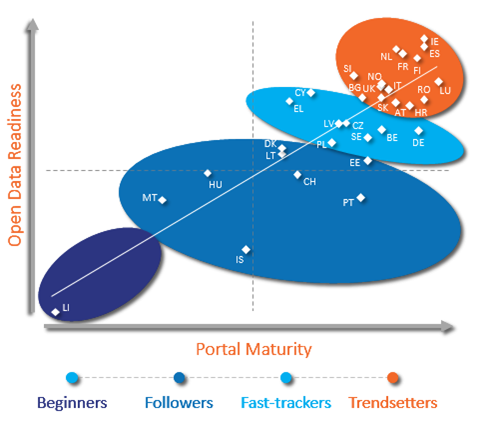Open Data Maturity in Europe 2017
European countries are racing to the top with Open Data in 2017
The latest EDP report on Open Data maturity reveals that governments across Europe have not only prioritised Open Data more strongly in 2017, but are actually engaging in a race to the top. Having measured the level of Open Data maturity across Europe for 3 consecutive years, it has become clear that EU countries have made considerable efforts to improve their publishing of Open Data.
European countries have been assessed both in terms of Open Data Readiness, assessing the span of their Open Data policies, and in terms of Open Data portal maturity. In general, EU countries score 72% in terms of their Open Data readiness in 2017 compared to 57% in 2016 and 46% in 2015. Similar results were captured on the Portal Maturity indicator, where the degree of maturity now reaches 76% in 2017 - a 10pp increase compared to 2016 and a significant step forward from a 32% maturity level in 2015. Combining the two indictors, the study reveals that where in 2015 EU countries had only completed 44% of their Open Data journey in reaching full Open Data maturity, this number had increased to 59% in 2016 and again increased to 73% in 2017.
In comparison to 2016, progress on the Open Data Readiness indicator can be observed on all three sub-indicators. Especially a significant increase across the EU28 in terms of measuring the political, economic and social impact of Open Data stands out with a spectacular combined increase of 23pp to reach 59% in 2017. This is followed by a 16pp increase in terms of Use of Data to 67% in 2017. However, EU countries appear most mature with regards to the sub-indicator on Open Data policy, increasing by 15pp to 82% in 2017; including a visible boost across the EU28 in terms of the degree of national coordination witnessing a spectacular increase of 35pp to reach 87% in 2017.
In terms of Portal Maturity, the most prominent development was made on the sub-indicator spread of data (+10pp compared to 2016), the best scoring sub-indicator across the board with a score of 90%. The re-usability of data follows in terms of progress, now reaching 77% - an increase of +15pp compared to 2016 followed by the usability of data with a moderate score of only 68% and an increase of only 3pp compared to 2016.
The overall Open Data Maturity groups countries into different clusters: Beginners, Followers, Fast-trackers and Trendsetters.
- Beginners: are in the early stages of their Open Data journey, both in terms of having an Open Data policy present as well as portal features.
- Followers: have successfully developed a basic Open Data policy and have brought in more advanced features on their portal. Limitations still exist in terms of data release.
- Fast-trackers: have significantly accelerated their Open Data journey, having either a policy or a portal that is substantially developed, however they still face a small number of shortcomings.
- Leaders - Trendsetters: have implemented an advanced Open Data policy with extensive portal features and national coordination mechanisms across domains.

As the picture above shows, in 2017 the number of trendsetters in the EU28 has nearly doubled to 14 countries in comparison to only 8 EU countries in 2016. All trendsetters show a clear drive in implementing their Open Data policies, developing additional portal features as well as understanding and documenting Open Data impact.
This development is seen beyond the EU borders as well, with positive developments made by the EFTA countries as well as encouraging signs from the EU accession countries, showing that Open Data has been placed higher on the national political agendas.
The report concludes on a series of seven recommendations to guide decision makers and Open Data Portal owners towards developing a sustainable vision for their Open Data transformation. A vision is needed to embed Open Data in a broader agenda for the digital transformation of the public sector as well as a solid strategy underpinning the development of the national data portal, as one of the components of the national data infrastructure.
View the Open Data Maturity dashboard
